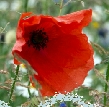|
         
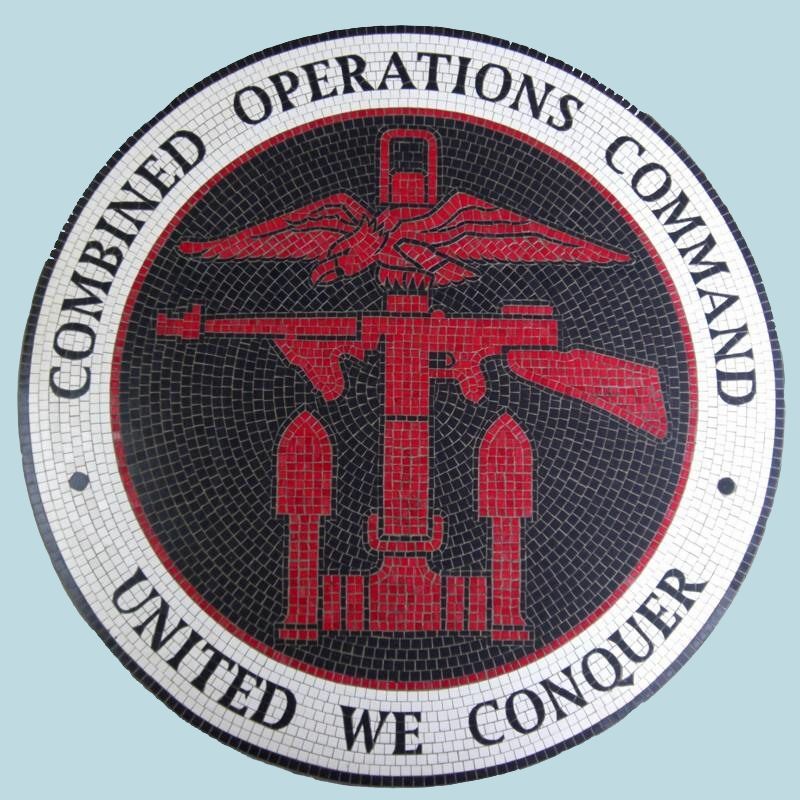 Welcome to the
Combined Ops Home Page & Website Welcome to the
Combined Ops Home Page & Website
Published
& hosted by
Geoff Slee
since 2000.
Most web pages can now be reached directly from this Home Page under the
following 6 headings -
Operations,
Units,
Training,
Science &
Technology,
Lest We
Forget and Help & Information. Scroll
down on this page or click on the link(s) above of interest and then scroll.
Featured links;
Combined Operations - a Brief
Introduction; 40 D Day Stories
and our
Jigsaw Challenge
where you can learn about aspects of Combined
Operations that may
surprise you.
|
|
|
Commando Raids
|
|
Operation Catapult,
Mers-el-Kebir
07/40 |
|
Operation Claymore, Lofoten Islands.
03/41 |
|
Bardia, N Africa.
04/41 |
|
Litani River, (Vichy French) Syria.
06/41 |
|
Operation Flipper
Rommel's HQ,
11/41 |
|
Operation Anklet,
Lofoten Islands
12/41 |
|
Operation Archery
Vaagso, Norway
12/41
|
|
Operation Biting
Bruneval, France,
02/42 |
|
Operation Chariot,
St Nazaire, France,
03/42 |
|
Operation Jubilee
Dieppe, France.
08/42 |
|
Operation Aquatint,
'Omaha', France.
09/42 |
|
Operation Torch, North
Africa
09/42 |
|
Operation Musketoon Glomfjiord
Norway
09/42 |
|
Operation Frankton,
Gironde, France.
12/42 |
|
Operation Corkscrew,
Pantelleria Med.
06/43 |
|
Operation Starkey raid
that never was. 09/43 |
|
Operation Brassard,
Elba, Italy.
06/44 |
|
Major Landings |
|
Operation Ironclad, Madagascar.
05/42 |
|
Operation Torch, North Africa.
11/42 |
|
Operation Husky,
Sicily, Italy.
07/42 |
|
Operation Avalanche,
Salerno, Italy.
09/43
|
|
Operation Neptune,
Normandy, France
06/44
|
|
Operation Infatuate
Walcheren, Holland
11/44 |
|
Operation Romulus,
Burma. .
01/45 |
|
Back to Top |
|
UNITS |
|
Land |
|
Small Scale Raiding Force
(SSRF) |
|
No 1 Commando |
|
No 4 Commando |
|
No 5 Commando |
|
No 9 Commando |
|
No 11 (Scot) Commando |
|
30 (Commando) Assault Unit |
|
50 Mid East Commando |
|
52 Mid East Commando |
|
W Commando (Canada) |
|
45 RM Commando (1) |
|
45 RM Commando (2) |
|
RN Commandos |
|
Sacred Squadron (Greece) |
|
574 Field Security
Section, Burma |
|
Pilotage Parties-COPPs |
|
Sea |
|
1. HQ & Mother Ships |
|
HQ Ships |
|
HMS Empire Battleaxe |
|
HMS Glenearn |
|
HMS Misoa |
|
HMS Royal Ulsterman |
|
2) Squadrons & Flotillas |
|
'I' Landing Craft Tank
Squadron |
|
Landing Craft
Support Squadron |
|
9th Landing Craft Tank Flotilla |
|
US
Landing Craft Rocket Flotilla |
|
10th Landing Craft Assault Flotilla |
|
519
Landing Craft Assault Flotilla |
|
601 Landing Craft
Mechanised Flotilla |
|
3) Individual Craft |
|
524 Landing Craft Assault - LCA |
|
Landing Craft Flack 7 |
|
Landing Craft Flack LCF |
|
Landing Craft Gun 13 |
|
Landing Craft Gun 19 |
|
Landing
Craft Rocket 363 - (LCT (R) 363 |
|
Landing Craft Tank 318 |
|
Landing Craft Tank 749 |
|
Landing Craft Tank 795 |
|
Landing Craft Tank 821 |
|
Landing Craft Tank 858 |
|
Landing Craft Tank 861 |
|
Landing Craft Tank 979 |
|
Landing Craft Tank 980 |
|
Landing Craft Tank 1171 |
|
Landing Craft Tank 2304 |
|
Landing Craft Tank 2331 |
|
814 Landing Craft Vehicle (Personnel) |
|
Landing Craft Vehicle (Personnel)
1228 |
|
Landing Ship Tank HMS Thruster |
|
US Landing Craft Infantry 502 |
|
US Landing Ship Tank 28 |
|
US Landing Craft Tank (Rocket) 439
|
|
US Landing Craft
Tank (Rocket)
|
|
4) Others |
|
Landing Barge Kitchen 6 |
|
Fighter Direction Tenders 13, 216 & 217 |
|
Harbour Defence Motor Launch 1301 |
|
New LCAs
Delivered |
|
(On D Day) |
|
Royal Observer Corps |
|
Air |
|
516 Squadron |
Royal Air Servicing
Commando Units
|
|
RASCU 3201 |
|
(On D Day) |
|
RAF Air/Sea Rescue |
|
Coastal Command |
|
Back to Top |
|
TRAINING |
|
Land Bases |
|
UK Combined Ops Training
Bases |
|
Middle East Combined
Training Centre, Kabret, Egypt (HMS Saunders). |
|
Signals Training
at Kabret. |
|
Operation Tiger Disaster |
|
No 1 Combined Training Centre,
Inveraray. |
|
Amphibious Training at Inveraray |
|
HMS Brontosaurus |
|
HMS COPRA |
|
RAF Dundonald, Ayrshire - 516 Squadron RAF |
|
Back to Top |
|
SCIENCE & TECH |
|
Mulberry Harbours |
|
PLUTO - Pipeline Under the Ocean |
|
PLUTO Salvaged |
|
PLUTO Production Machinery |
|
PLUTO in Fawley |
|
Pykrete Ice Ships! |
|
Fighter Direction Tenders 13, 216 & 217.
|
|
Duplex Drive Swimming Tanks (Hobart's
Funnies) |
|
Back to Top |
|
LEST
WE FORGET |
|
Remembrance |
|
Roll of Honour |
|
They Also Served |
|
Combined Operations
Memorial Dedication |
|
General
Barrons' Speech |
|
Special
Thanks |
|
Visiting the Memorial |
|
In Perpetuity Memorial Maintenance |
|
Donate to
Memorial Maintenance |
|
Memorials,
Monuments & Plaques |
|
Poetry |
|
Biographies |
|
Lord Mountbatten |
|
Sir Roger Keyes |
|
Geoffrey Pyke |
|
Lt Douglas A Grant |
|
Rickard
C Donovan |
|
Personal Wartime
Recollections |
|
Inveraray,
Scotland |
|
Occupied
Walcheren |
|
US British
Commando |
|
I Saw the
World |
|
Minor
Landing Craft Training |
|
Secretary at COHQ |
|
RN Signaller's D
Story |
|
LAC's D
Day Diary |
|
Heritage |
|
First Combined
Operation in 1759! |
|
LCT
7074 Restoration |
|
HDML
1301 Recovery |
|
Combined Operations Heritage |
|
Combined
Operations Badge History |
|
Combined
Operations Badge Specimens |
|
Combined
Operations Badges in Use |
|
Back to Top |
|
HELP
& INFO |
|
Website Services |
|
Membership (Supports the Website
& Memorial) |
|
Search |
|
FAQ (Including Forces Records) |
|
List of 300 Books |
|
External Links |
|
Notice Board
(Ops & Units) |
|
Notice Board (Veterans) |
|
Notice
Board (Other) |
|
Jigsaw
Challenge |
|
D Day Beach Landings
Interactive Painting |
|
Become a researcher / writer for this website |
|
Landing Craft Crews |
|
'Normandy
Beachhead' prints for sale |
|
Events & Places
|
|
About Us |
|
Contact Us |
|
Background to Website |
|
Website
Terms of Use |
|
List of Members |
|
Website
Accounts |
|
Other Material |
|
A Nation's Gratitude to Combined Operations |
|
Hitler's Infamous
Commando Order |
|
Hitler's Western Front
Order |
|
Post WW2
Combined Operations |
|
Memorial Construction Fund |
|
Memorial
Design, Materials, Construction & Dedication |
|
Back to Top |
|
|
| |
|
The Command's Formation & Purpose
After the Dunkirk
Evacuation of the defeated Allied Expeditionary Force in early June
1940, Churchill decreed that a new joint or combined fighting force (land,
sea and air) was required, whose unique challenge and sole purpose was to
plan, train for and undertake offensive
amphibious operations against the enemy, avoiding distractions arising from
defensive considerations.
Initially,
Small Scale Amphibious Raiding Forces were formed,
which soon developed into larger, better trained and equipped
Commando Units, each around 500 men in strength. They raided coastal
areas of enemy occupied territories from northern Norway to south west
France, causing the Germans to reinforce their coastal defences including
the deployment of thousands of additional troops taken from other duties.
Special Forces, including the Special Boat Service (SBS) and Special Air
Services (SAS), took the Commando concept to a new level for clandestine
operations behind enemy lines.
[Photos below, in
order of appearance are; Churchill, Keyes, Mountbatten and Laycock].
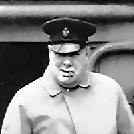 Concurrent
with these developments, plans were prepared for large scale landings
(invasions) onto unimproved beaches in countries occupied by the enemy,
which culminated in the D Day landings. The Combined Operations Command
was not to be distracted from its offensive operations task by the
unfolding events of war as the three traditional services concentrated
their resources in defence of the UK and her interests. Concurrent
with these developments, plans were prepared for large scale landings
(invasions) onto unimproved beaches in countries occupied by the enemy,
which culminated in the D Day landings. The Combined Operations Command
was not to be distracted from its offensive operations task by the
unfolding events of war as the three traditional services concentrated
their resources in defence of the UK and her interests.
In fulfilling this
task, RAF actions included the Battle of Britain, bombing raids, coastal
defence patrols, U-boat detection and support for Combined Operations raids
and landings, while the Royal Navy defended trade routes, detected and
destroyed surface raiders and U-boats, maintained a maritime blockade of
Germany, defended UK coasts and escorted and supported Combined Operations
raids and landings.
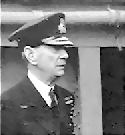 After
a period of re-equipping and training, including Combined Operations landing
craft training, the Army saw action in North Africa, Madagascar, Sicily,
Italy, East Africa, southern France, Normandy, Holland, the Rhine Crossing
and the Far East, assisted throughout by the forces of the Combined
Operations Command during amphibious landings. After
a period of re-equipping and training, including Combined Operations landing
craft training, the Army saw action in North Africa, Madagascar, Sicily,
Italy, East Africa, southern France, Normandy, Holland, the Rhine Crossing
and the Far East, assisted throughout by the forces of the Combined
Operations Command during amphibious landings.
For the purposes of
training and offensive amphibious operations against the enemy, all RNVR and
RN landing craft officers and ratings, and their Royal Navy landing craft,
were attached to the Combined Operations Command, itself staffed by Royal
Navy, Army and Royal Air Force personnel under the command of naval men
Keyes and Mountbatten from July 1940 to October 1943 and Major General
Laycock until 1947.
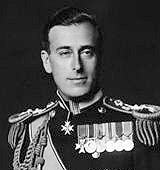 Under
their stewardship and close liaison with the Joint Chiefs of Staff,
extensive training in the use of landing craft through dozens of
Training Establishments, mainly in central Scotland and the south of
England, were set up. For pay and accounting purposes
HMS Copra was established for RNVR and RN personnel attached to the
Combined Operations Command. Under
their stewardship and close liaison with the Joint Chiefs of Staff,
extensive training in the use of landing craft through dozens of
Training Establishments, mainly in central Scotland and the south of
England, were set up. For pay and accounting purposes
HMS Copra was established for RNVR and RN personnel attached to the
Combined Operations Command.
The training
included general seafaring, joint army/navy training in all aspects of
amphibious warfare using landing craft with RAF support, particularly at the
No 1 Combined Training Centre at Inveraray on Loch Fyne.
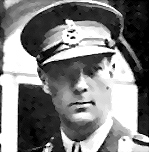 In
the final stages of training, 516 Squadron RAF (also attached to the
Command) created realistic war conditions by attacking the landing beaches
with live ammunition, small bombs and smoke canisters. This was
usually followed by many months of joint Army/Navy training exercises in
loading, unloading, forming and maintaining position in convoys and mock
beach landings. In
the final stages of training, 516 Squadron RAF (also attached to the
Command) created realistic war conditions by attacking the landing beaches
with live ammunition, small bombs and smoke canisters. This was
usually followed by many months of joint Army/Navy training exercises in
loading, unloading, forming and maintaining position in convoys and mock
beach landings.
The
Command's Development
On June 4th 1940, as
the last of the troops were evacuated from the beaches of Dunkirk, Churchill
sent a memorandum to his Chief Military Assistant and Staff Officer, General
Ismay. He was Churchill's main communications link with the Chiefs of Staff.
The memorandum warned against the dangers of concentrating too much on the
defence of the United Kingdom against enemy attack or invasion. "It is of
the highest consequence to keep the largest numbers of German forces all
along the coasts of the countries they have conquered, and we should
immediately set to work to organise raiding forces on these coasts where the
populations are friendly." Two days later, he continued on the same theme,
"I look to the Chiefs of Staff to propose me measures for a vigorous,
enterprising and ceaseless offensive against the whole German-occupied
coastline."
On the 14th of June, the Chiefs of staff appointed Lieutenant-General Alan
Bourne to the amply described post of "Commander of Raiding Operations on
coasts in enemy occupation, and Adviser to the Chiefs of Staff on Combined
Operations." Bourne was 58 and had been in charge of the Royal Marines for
about a year. His wide experience on land and sea, and attendance at the
Imperial Defence and Army Staff Colleges, were no doubt factors in his
selection for this new and challenging post.
Churchill was not consulted about the
appointment during these frenzied and anxious times. Whilst he held Bourne
in high regard, he felt he was too close to the Admiralty to be able to
operate without undue influence from them and he lacked the seniority and
authority to deal with the three Ministries. On the 17th of July 1940,
Churchill appointed Admiral of the fleet,
Roger Keyes to the newly named post of
Director of
Combined Operations.
He was succeeded by
Lord Louis Mountbatten, who held the redefined
post from 27/10/41 until he moved to Burma in October 1943. Major General
Robert Laycock then held the post until
1947.
Combined Operations made a huge contribution to the successful outcome of
the Second World War by undertaking dozens of Commando raids and landings,
mostly against the Axis forces, from Norway in the north to Madagascar in
the south and from North Africa and the Mediterranean in the west to the Far
East, culminating in the
D-Day Invasion
on the 6th of June 1944.
The Command drew on
the best practices and expertise the Royal Navy, the Army and the Royal Air
Force had to offer to create a unified force. Many of their top
planners and experts formed the nucleus around which the Command was formed
and, as the requirements of offensive operations took on an international
dimension, the service personnel of many Allied countries proudly wore the
Combined Operations badge.
In addition to the nations represented by the flags in the banner heading,
German speaking refugees from the following countries served in No 10
Inter-Allied Commando, particularly No 3 Troop. They were; Austria,
Czechoslovakia, Denmark, Germany, Hungary, Romania, Russia and Yugoslavia.
Greece's Sacred Commando Squadron was not
part of Combined Operations but in all regards they served the Allied cause
in defence of their Homeland.
The 'All Pages Index'
in the page banner heading has brief descriptions of around 190 web pages
about this amazing and ubiquitous WWII organisation whose auspices included
such diverse subjects as
Commando Raids and Major
Landings, Landing Craft Training
for hundreds of thousands,
Mulberry Harbours, the
PLUTO Pipeline
project, "Hobarts Funnies" tank adaptations and even top secret
experiments on an unsinkable
"Ice Ship" in the Rocky mountains.
It's a testimony to
the enduring nature of the Combined Operations concept that the
Combined Operations Badge, designed
by
Lt D A Grant,
RNVR, in 1942, is still in use to this day in a number of
countries worldwide.
The
Combined Ops Memorial
If you plan to
visit the memorial, you'll find useful information on the link to help
you make the most of your day.
On Thursday, July 4th 2013,
in the presence of Her Majesty's Lord Lieutenant of Staffordshire, Mr Ian
Dudson, CBE and 200 guests, including 25 WW2 veterans and 6 Standard
Bearers, the Combined Operations Command Memorial was unveiled by General
Sir Richard Barrons KCB CBE ADC Gen, Commander of the Joint Forces Command.
It was dedicated by the Reverend Prebendary, Tony Wood.
No greater honour
could be bestowed on the service personnel of yesteryear, than for the
Commander of their modern equivalent Force to honour their memory,
sacrifices and achievements in this way.
 A
Spontaneous Act of Heartfelt Appreciation A
Spontaneous Act of Heartfelt Appreciation
In the summer of 2004, a
WW2 veteran from Canada and his friend were travelling north to
Scotland by rail, having attended the 60th anniversary D-Day commemorations
in Normandy. They engaged an elderly lady in conversation and found they had
much in common. The veteran had served in Combined Operations as an LAC on a
radar vessel off the beaches of Normandy and her late husband had been an
officer in the Combined Operations Pilotage Parties (COPPs). His clandestine
visits to the landing beaches prior to invasions, provided invaluable
intelligence on enemy defences, hidden obstacles and beach and tidal
conditions.
The miles drifted by almost unnoticed as
they relived their youthful memories of wartime... for she had also served
her country in the WAAF, including some time at RAF Charterhall, near
Kelso, in the Scottish Borders.
Unbeknown to them all, a young business woman, sitting nearby, overheard
much of the animated conversation over several hours. At York she slid a
sealed envelope onto their table as she left the train. She was gone before
they had time to gather their senses.
Wherever you are in
the world, your life has certainly been touched by the achievements and
sacrifices of those who served under the Combined Operations Command in WW2.
Viv felt compelled to show her appreciation and gratitude having heard but a
tiny fraction of the experiences of just a couple of veterans.
Further Reading
Use the links opposite or the website's
main Index page
for access to 200 web pages about different aspects of Combined Operations,
including 40 D Day accounts from veterans who served in or alongside
Combined Operations. These are now unique personal testimonies of an important time in the history of the world.
There are around
300 books listed on our 'Combined Operations Books'
page. They, or any other books you know about, can be purchased on-line from
the Advanced Book Exchange (ABE). Their search banner link, on our 'Books'
page, checks the shelves of thousands of book shops world-wide. Just type
in, or copy and paste the title of your choice, or use the 'keyword' box for
book suggestions. There's no obligation to buy, no registration and no
passwords.
Monitored by SiteUptime.
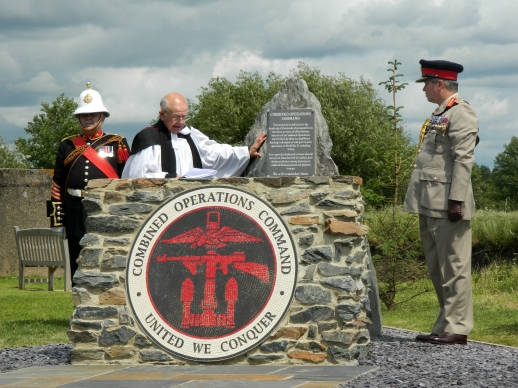
[General
Sir Richard Barrons looks on as the Revd Prebendary Tony Wood dedicates the
Combined Operations memorial].
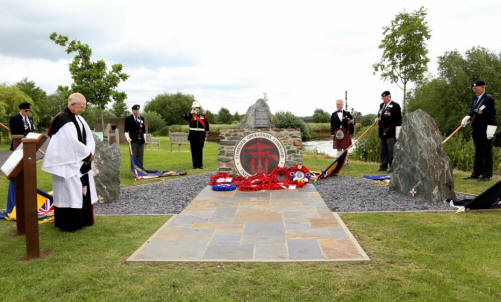
[The
Combined Operations Command Memorial dedication ceremony, July 4th, 2013 at
the National Memorial Arboretum in Staffordshire, England. Entirely funded
by veterans, their families and friends].
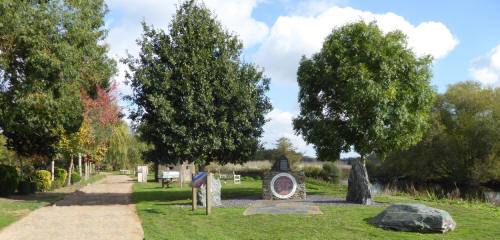
[The Memorial as it was, 9 years later, in
October 2022].
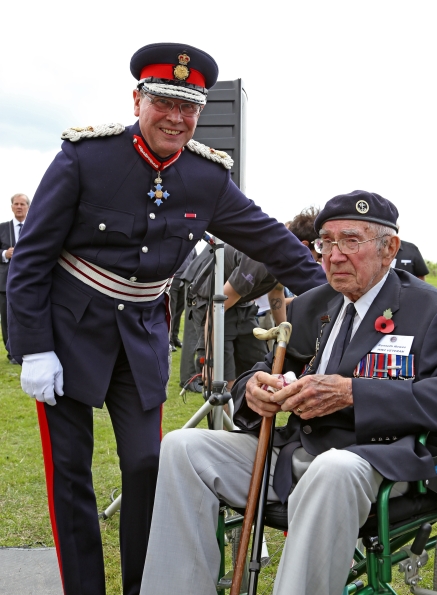
[Photo; Lord Lieutenant
of Staffordshire , Mr Ian Dudson, with WW2 Veteran Kenneth Howes at the
memorial dedication ceremony].

[Memorial location map courtesy of Google Map Data 2017].
|




 Concurrent
with these developments, plans were prepared for large scale landings
(invasions) onto unimproved beaches in countries occupied by the enemy,
which culminated in the D Day landings. The Combined Operations Command
was not to be distracted from its offensive operations task by the
unfolding events of war as the three traditional services concentrated
their resources in defence of the UK and her interests.
Concurrent
with these developments, plans were prepared for large scale landings
(invasions) onto unimproved beaches in countries occupied by the enemy,
which culminated in the D Day landings. The Combined Operations Command
was not to be distracted from its offensive operations task by the
unfolding events of war as the three traditional services concentrated
their resources in defence of the UK and her interests. After
a period of re-equipping and training, including Combined Operations landing
craft training, the Army saw action in North Africa, Madagascar, Sicily,
Italy, East Africa, southern France, Normandy, Holland, the Rhine Crossing
and the Far East, assisted throughout by the forces of the Combined
Operations Command during amphibious landings.
After
a period of re-equipping and training, including Combined Operations landing
craft training, the Army saw action in North Africa, Madagascar, Sicily,
Italy, East Africa, southern France, Normandy, Holland, the Rhine Crossing
and the Far East, assisted throughout by the forces of the Combined
Operations Command during amphibious landings. Under
their stewardship and close liaison with the Joint Chiefs of Staff,
extensive training in the use of landing craft through dozens of
Under
their stewardship and close liaison with the Joint Chiefs of Staff,
extensive training in the use of landing craft through dozens of
 In
the final stages of training, 516 Squadron RAF (also attached to the
Command) created realistic war conditions by attacking the landing beaches
with live ammunition, small bombs and smoke canisters. This was
usually followed by many months of joint Army/Navy training exercises in
loading, unloading, forming and maintaining position in convoys and mock
beach landings.
In
the final stages of training, 516 Squadron RAF (also attached to the
Command) created realistic war conditions by attacking the landing beaches
with live ammunition, small bombs and smoke canisters. This was
usually followed by many months of joint Army/Navy training exercises in
loading, unloading, forming and maintaining position in convoys and mock
beach landings. A
Spontaneous Act of Heartfelt Appreciation
A
Spontaneous Act of Heartfelt Appreciation




